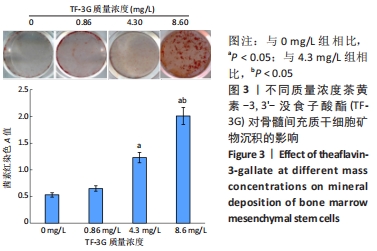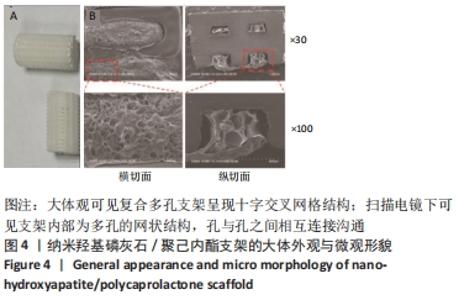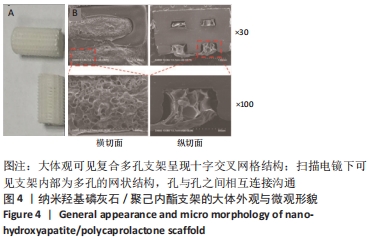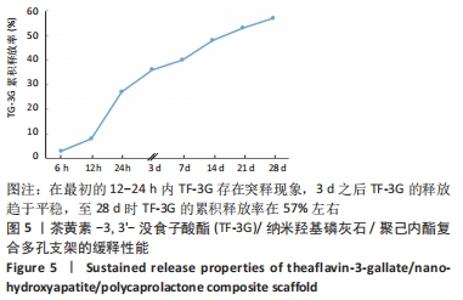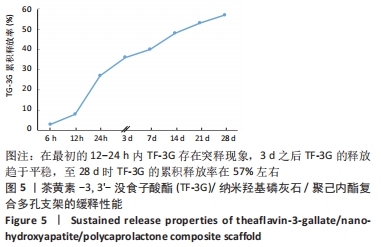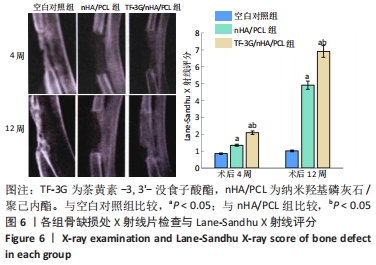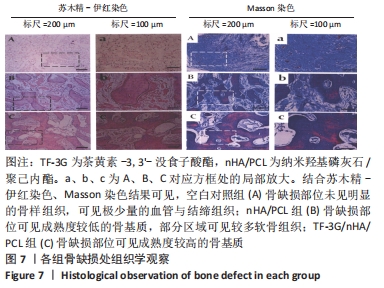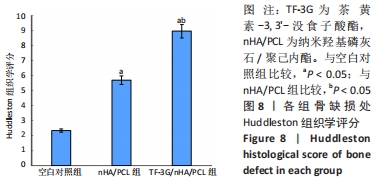Chinese Journal of Tissue Engineering Research ›› 2022, Vol. 26 ›› Issue (22): 3480-3486.doi: 10.12307/2022.274
Previous Articles Next Articles
Theaflavin-3-gallate modified nano-hydroxyapatite/polycaprolactone composite porous scaffold in bone defect repair
Liu Ming, Wang Kai
- First Department of Orthopedics, Qinghai Provincial People’s Hospital, Xining 810000, Qinghai Province, China
-
Received:2020-12-29Revised:2021-01-26Accepted:2021-06-06Online:2022-08-08Published:2022-01-11 -
Contact:Wang Kai, Chief physician, First Department of Orthopedics, Qinghai Provincial People’s Hospital, Xining 810000, Qinghai Province, China -
About author:Liu Ming, Master, Associate chief physician, First Department of Orthopedics, Qinghai Provincial People’s Hospital, Xining 810000, Qinghai Province, China
CLC Number:
Cite this article
Liu Ming, Wang Kai. Theaflavin-3-gallate modified nano-hydroxyapatite/polycaprolactone composite porous scaffold in bone defect repair[J]. Chinese Journal of Tissue Engineering Research, 2022, 26(22): 3480-3486.
share this article
Add to citation manager EndNote|Reference Manager|ProCite|BibTeX|RefWorks

2.1 TF-3G的细胞毒性 培养72 h后CCK-8检测结果显示,0.86,4.30,8.60,17.20,34.4,68.8,86,106,126,146 mg/L TF-3G溶液组的相对细胞增殖率分别为95.35%,107.35%,118.09%,125.34%,110.72%,93.27%,88.79%,74.13%,68.13%,59.23%,显示0.86-86 mg/L TF-3G溶液的毒性分级为0级,106 mg/L TF-3G溶液的毒性为1级,而126,146 mg/L TF-3G溶液的细胞毒性为2级;阴性对照组的相对细胞增殖率为98.62%,阳性对照组为11.38%,说明此次实验结果符合细胞毒性反应国家分级标准。 2.2 TF-3G对细胞增殖活性的影响 培养第1天时,各组之间细胞增殖活性比较差异无显著性意义(P > 0.05);培养第3天时,34.4,68.8,86,106 mg/L组的细胞增殖活性低于0 mg/L组(P < 0.05),其余各浓度组细胞增殖活性与0 mg/L组比较差异无显著性意义(P > 0.05);培养第5天时,4.30,8.60 mg/L组的细胞增殖活性高于0 mg/L浓度组(P < 0.05),17.20,34.4,68.8,86,106 mg/L组的细胞增殖活性低于0 mg/L组(P < 0.05),0.86 mg/L组的增殖活性与0 mg/L组比较差异无显著性意义(P > 0.05),并且8.60 mg/L组细胞增殖活性高于0.86,4.30 mg/L组(P < 0.05);培养第7天时,0.86,4.30,8.60 mg/L组的细胞增殖活性高于0 mg/L组(P < 0.05),17.20,34.4,68.8,86,106 mg/L组的细胞增殖活性低于0 mg/L组(P < 0.05),并且8.60 mg/L组的细胞增殖活性高于0.86,4.30 mg/L组(P < 0.05),见表3。各组细胞增殖情况见图1。"

| [1] GRAHAM SM, LEONIDOU A, ASLAM-PERVEZ N, et al. Biological therapy of bone defects: the immunology of bone allo-transplantation. Expert Opin Biol Ther. 2010;10(6):885-901. [2] AHMED GA, ISHAQUE B, RICKERT M, et al. Allogeneic bone transplantation in hip revision surgery : Indications and potential for reconstruction. Orthopade. 2018;47(1):52-66. [3] CHU W. Treatment of nonunion with autologous bone transplantation combined with platelet-rich plasma and extracorporeal shock wave. Zhongguo Gu Shang. 2019;32(5):434-439. [4] 余幸鸽,林开利.基于天然水凝胶的生物材料在骨组织工程中的应用[J].中国生物工程杂志,2020,40(5):69-77. [5] HOLZAPFEL BM, RUDERT M, HUTMACHER DW. Scaffold-based Bone Tissue Engineering. Orthopade. 2017;46(8):701-710. [6] ZHOU X, SHI G, FAN B, et al. Polycaprolactone electrospun fiber scaffold loaded with iPSCs-NSCs and ASCs as a novel tissue engineering scaffold for the treatment of spinal cord injury. Int J Nanomedicine. 2018;13:6265-6277. [7] 武小童,何儿,刘来俊,等.基于聚己内酯纤维的组织工程支架研究进展[J].中国生物医学工程学报,2020,39(5):611-620. [8] TEOH SH, GOH BT, LIM J. Three-Dimensional Printed Polycaprolactone Scaffolds for Bone Regeneration Success and Future Perspective. Tissue Eng Part A. 2019;25(13-14):931-935. [9] ALEMÁN-DOMÍNGUEZ ME, GIUSTO E, ORTEGA Z, et al. Three-dimensional printed polycaprolactone-microcrystalline cellulose scaffolds. J Biomed Mater Res B Appl Biomater. 2019;107(3):521-528. [10] DAAS I, BADR S, OSMAN E. Comparison between Fluoride and Nano-hydroxyapatite in Remineralizing Initial Enamel Lesion: An in vitro Study. J Contemp Dent Pract. 2018;19(3):306-312. [11] GIZER M, KÖSE S, KARAOSMANOGLU B, et al. The Effect of Boron-Containing Nano-Hydroxyapatite on Bone Cells.Biol Trace Elem Res. 2020;193(2):364-376. [12] 胡超然,邱冰,周祝兴,等.3D打印聚己内酯/纳米羟基磷灰石复合支架与骨髓间充质干细胞的体外生物相容性[J].中国组织工程研究,2020,24(4):589-595. [13] NAUDOT M, GARCIA GARCIA A, JANKOVSKY N, et al. The combination of a poly-caprolactone/nano-hydroxyapatite honeycomb scaffold and mesenchymal stem cells promotes bone regeneration in rat calvarial defects. J Tissue Eng Regen Med. 2020;14(11):1570-1580. [14] ROBERTS EAH, CARTWRIGHT RA, OLDSCHOOL M. The phenolic substances of manufactured tea. I. —Fractionation and paper chromatography of water‐soluble substances. J Sci Food Agric. 1957; 8(2):72-80. [15] 尚希福,路玉峰,张文志,等.茶黄素对人骨髓基质干细胞的成骨诱导作用[J].山东医药,2010,50(19):7-9. [16] 赵传勇,丁艳芳,张文志,等.骨髓间充质干细胞联合茶黄素修复激素性股骨头坏死[J].中国组织工程研究,2015,19(32):5210-5214. [17] Oka Y, Iwai S, Amano H, et al. Tea Polyphenols Inhibit Rat Osteoclast Formation and Differentiation. J Pharmacol Sci. 2012;118(1):55-64. [18] 辛红美,许洁,汪长东.淫羊藿苷促进MC3T3-E1成骨分化通过Hedgehog信号通路[J].中国药理学通报,2020,36(5):616-620. [19] 向声燚,焦志伟,马昊鹏,等.聚己内酯/纳米羟基磷灰石复合材料的3D打印及性能[J].工程塑料应用,2018,46(8):122-125,130. [20] JIN Y, ZHANG W, LIU Y, et al. rhPDGF-BB via ERK pathway osteogenesis and adipogenesis balancing in ADSCs for critical-sized calvarial defect repair. Tissue Eng Part A. 2014;20(23-24):3303-3313. [21] INODA H, YAMAMOTO G, HATTORI T. Histological investigation of osteoinductive properties of rh-BMP2 in a rat calvarial bone defect model. J Craniomaxillofac Surg. 2004;32(6):365-369. [22] 李树源,周琦石,周宏亮,等.强骨胶囊辅助诱导膜技术治疗感染性骨髓炎并骨缺损临床观察[J].山东医药,2019,59(19):73-76. [23] HUDDLESTON PM, STECKELBERG JM, HANSSEN AD, et al. Ciprofloxacin inhibition of experimental fracture healing. J Bone Joint Surg Am. 2000; 82(2):161-173. [24] FENNEMA EM, TCHANG LAH, YUAN H, et al. Ectopic bone formation by aggregated mesenchymal stem cells from bone marrow and adipose tissue: A comparative study. J Tissue Eng Regen Med. 2018;12(1): e150-e158. [25] 董晨露.骨髓间充质干细胞成骨分化的研究与进展[J].中国骨伤杂志,2019,32(3):288-292. [26] NISHIKAWA K, IWAMOTO Y, KOBAYASHI Y, et al. DNA methyltransferase 3a regulates osteoclast differentiation by coupling to an S-adenosylmethionine-producing metabolic pathway. Nat Med. 2015; 21(3):281-287. [27] CHAI S, WAN L, WANG JL, et al. Gushukang inhibits osteocyte apoptosis and enhances BMP-2/Smads signaling pathway in ovariectomized rats. Phytomedicine. 2019;64:153063. [28] FENG C, XIAO L, YU JC, et al. Simvastatin promotes osteogenic differentiation of mesenchymal stem cells in rat model of osteoporosis through BMP-2/Smads signaling pathway. Eur Rev Med Pharmacol Sci. 2020;24(1):434-443. [29] MOON SH, KIM I, KIM SH. Mollugin enhances the osteogenic action of BMP-2 via the p38-Smad signaling pathway. Arch Pharm Res. 2017; 40(11):1328-1335. [30] CHUNG YH, HUANG YH, CHU TH, et al. BMP-2 restoration aids in recovery from liver fibrosis by attenuating TGF-beta1 signaling. Lab Invest. 2018;98(8):999-1013. [31] REN C, GONG W, LI F, et al. Pilose antler aqueous extract promotes the proliferation and osteogenic differentiation of bone marrow mesenchymal stem cells by stimulating the BMP-2/Smad1, 5/Runx2 signaling pathway. Chin J Nat Med. 2019;17(10):756-767. [32] YANG G, YUAN G, LI X, et al. BMP-2 induction of Dlx3 expression is mediated by p38/Smad5 signaling pathway in osteoblastic MC3T3-E1 cells. J Cell Physiol. 2014;229(7):943-954. [33] YODTHONG T, KEDJARUNE-LEGGAT U, SMYTHE C, etal.l-Quebrachitol Promotes the Proliferation, Differentiation, and Mineralization of MC3T3-E1 Cells: Involvement of the BMP-2/Runx2/MAPK/Wnt/beta-Catenin Signaling Pathway. Molecules. 2018;23(12):3086. [34] MOON SH, KIM I, KIM SH. Mollugin enhances the osteogenic action of BMP-2 via the p38-Smad signaling pathway. Arch Pharm Res. 2017; 40(11):1328-1335. [35] 金光辉,孙晓飞,夏琰,等.选择性激光烧结法构建纳米羟基磷灰石与聚己内酯复合材料人工骨支架[J].第二军医大学学报,2015, 36(12): 1289-1294. [36] 金光辉,张馨雯,孙晓飞,等.组织工程化纳米羟基磷灰石/聚己内酯人工骨支架修复兔桡骨大段骨缺损的实验研究[J].中华损伤与修复杂志(电子版),2015(1):43-49. [37] QIN T, LI X, LONG H, et al. Bioactive Tetracalcium Phosphate Scaffolds Fabricated by Selective Laser Sintering for Bone Regeneration Applications. Materials (Basel). 2020;13(10):2268. |
| [1] | Xue Yadong, Zhou Xinshe, Pei Lijia, Meng Fanyu, Li Jian, Wang Jinzi . Reconstruction of Paprosky III type acetabular defect by autogenous iliac bone block combined with titanium plate: providing a strong initial fixation for the prosthesis [J]. Chinese Journal of Tissue Engineering Research, 2022, 26(9): 1424-1428. |
| [2] | Gao Yujin, Peng Shuanglin, Ma Zhichao, Lu Shi, Cao Huayue, Wang Lang, Xiao Jingang. Osteogenic ability of adipose stem cells in diabetic osteoporosis mice [J]. Chinese Journal of Tissue Engineering Research, 2022, 26(7): 999-1004. |
| [3] | Wu Weiyue, Guo Xiaodong, Bao Chongyun. Application of engineered exosomes in bone repair and regeneration [J]. Chinese Journal of Tissue Engineering Research, 2022, 26(7): 1102-1106. |
| [4] | Zhou Hongqin, Wu Dandan, Yang Kun, Liu Qi. Exosomes that deliver specific miRNAs can regulate osteogenesis and promote angiogenesis [J]. Chinese Journal of Tissue Engineering Research, 2022, 26(7): 1107-1112. |
| [5] | Chen Xiaoxu, Luo Yaxin, Bi Haoran, Yang Kun. Preparation and application of acellular scaffold in tissue engineering and regenerative medicine [J]. Chinese Journal of Tissue Engineering Research, 2022, 26(4): 591-596. |
| [6] | Kang Kunlong, Wang Xintao. Research hotspot of biological scaffold materials promoting osteogenic differentiation of bone marrow mesenchymal stem cells [J]. Chinese Journal of Tissue Engineering Research, 2022, 26(4): 597-603. |
| [7] | Wang Ruanbin, Cheng Liqian, Chen Kai. Application and value of polymer materials in three-dimensional printing biological bones and scaffolds [J]. Chinese Journal of Tissue Engineering Research, 2022, 26(4): 610-616. |
| [8] | Li Hui, Chen Lianglong. Application and characteristics of bone graft materials in the treatment of spinal tuberculosis [J]. Chinese Journal of Tissue Engineering Research, 2022, 26(4): 626-630. |
| [9] | Tan Guozhong, Tu Xinran, Guo Liyang, Zhong Jialin, Zhang Yang, Jiang Qianzhou. Biosafety evaluation of three-dimensional printed gelatin/sodium alginate/58S bioactive glass scaffolds for bone defect repair [J]. Chinese Journal of Tissue Engineering Research, 2022, 26(4): 521-527. |
| [10] | He Guanyu, Xu Baoshan, Du Lilong, Zhang Tongxing, Huo Zhenxin, Shen Li. Biomimetic orientated microchannel annulus fibrosus scaffold constructed by silk fibroin [J]. Chinese Journal of Tissue Engineering Research, 2022, 26(4): 560-566. |
| [11] | Guan Jian, Jia Yanfei, Zhang Baoxin , Zhao Guozhong. Application of 4D bioprinting in tissue engineering [J]. Chinese Journal of Tissue Engineering Research, 2022, 26(3): 446-455. |
| [12] | Han Zhi, Wang Zhimiao, Gaxi Sijia, Lu Qingling, Guo Tao. Tissue engineered cartilage constructed by polyurethane composite chondrocytes [J]. Chinese Journal of Tissue Engineering Research, 2022, 26(22): 3455-3459. |
| [13] | Tang Zhenzhou, Gu Yong, Chen Liang. Preparation of modified dextran composite hydrogel with osteogenetic effect and in vitro experiment [J]. Chinese Journal of Tissue Engineering Research, 2022, 26(22): 3521-3527. |
| [14] | Meng Lulu, Liu Hao, Liu Han, Zhang Jun, Li Ruixin, Gao Lilan. Mechanical properties of silk fibroin/type I collagen/hydroxyapatite scaffolds based on low-temperature 3D printing [J]. Chinese Journal of Tissue Engineering Research, 2022, 26(22): 3550-3555. |
| [15] | Guo Xiaopeng, Liu Yingsong, Shang Hui. Silk fibroin/nano hydroxyapatite composite combined with icariin can promote the proliferation and differentiation of bone marrow mesenchymal stem cells into nucleus pulposus like cells [J]. Chinese Journal of Tissue Engineering Research, 2022, 26(22): 3528-3534. |
| Viewed | ||||||
|
Full text |
|
|||||
|
Abstract |
|
|||||





